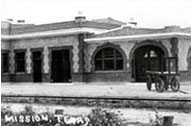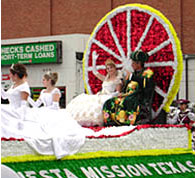Nearly 250 years ago tracts of land in this area were granted to settlers from Mexico in an effort to establish a stable and permanent Spanish presence in the area. These tracts, called porciones, were nine-thirteenths of a mile wide at the Rio Grande, and extended as far as sixteen miles perpendicular to the river. This was done to ensure at least some access to water for the settlers. Legal descriptions of land in the area still reference the original numbered porciones.
 Part of the land where Mission would one day be located was purchased from descendants of the original grantee by M. Guillermo Rene Guyard in 1845. Guyard set aside an area for the use of the Oblates of Mary Immaculate, whose itinerant priests traveled through the area to minister to the spiritual needs of ranch owners and workers. The Oblate Fathers built a small chapel at Rancho La Lomita in 1865. This building has been restored, and still stands today. The mission at La Lomita was maintained by the Oblates for many years, and a small settlement began to grow in the area.
Part of the land where Mission would one day be located was purchased from descendants of the original grantee by M. Guillermo Rene Guyard in 1845. Guyard set aside an area for the use of the Oblates of Mary Immaculate, whose itinerant priests traveled through the area to minister to the spiritual needs of ranch owners and workers. The Oblate Fathers built a small chapel at Rancho La Lomita in 1865. This building has been restored, and still stands today. The mission at La Lomita was maintained by the Oblates for many years, and a small settlement began to grow in the area.
In 1904, the Missouri Pacific railroad was extended north and west from Brownsville. The new railroad passed about four miles north of the settlement at La Lomita and served the farmers and merchants in the growing community.
In 1906, developers John J. Conway and J. W. Hoit purchased large tracts of land in the area, including that owned by the Oblate Fathers. Conway and Hoit established the Rancho La Lomita Land Company in the area.
In 1908, they provided the railroad with a new station and siding, and the area around the station became the center of settlement in the area. Because there was already a station in Texas named “Lomita,” another name had to be chosen. The new station, and the town around it, was named “Mission” in 1908.
 The new town of Mission, soon had a post office, a school, and a pharmacy. A newspaper and a hotel were added in 1909, and the city incorporated in 1910. It was also around this time that developers such as John H. Shary saw the potential for large scale production of citrus fruit in the Mission area. With water for irrigation, and the railway to take fruit to northern markets, everything was in place for an explosive growth of the citrus industry. Shary, and others, were instrumental in promoting the Valley as an agricultural paradise with a year-round growing season. Many farmers from northern states purchased land and moved to the Valley at this time.
The new town of Mission, soon had a post office, a school, and a pharmacy. A newspaper and a hotel were added in 1909, and the city incorporated in 1910. It was also around this time that developers such as John H. Shary saw the potential for large scale production of citrus fruit in the Mission area. With water for irrigation, and the railway to take fruit to northern markets, everything was in place for an explosive growth of the citrus industry. Shary, and others, were instrumental in promoting the Valley as an agricultural paradise with a year-round growing season. Many farmers from northern states purchased land and moved to the Valley at this time.
The City of Mission continues to expand from the humble beginnings of La Lomita. Although citrus production is still a major industry in the area, other agriculture and commerce have grown exponentially in recent years. Mission has also become a favorite destination for bird and butterfly watchers, golfers, and northerners looking to escape the cold. The history of our community continues to be written every day by those who live, work and play in Mission, TX.
